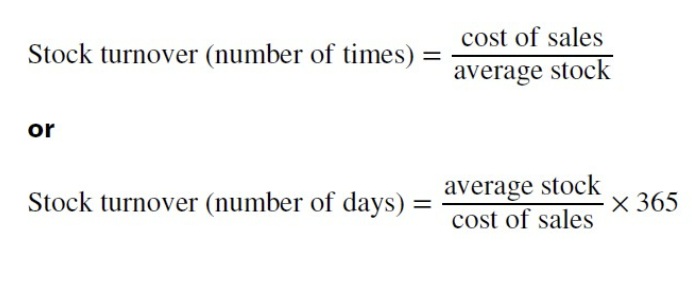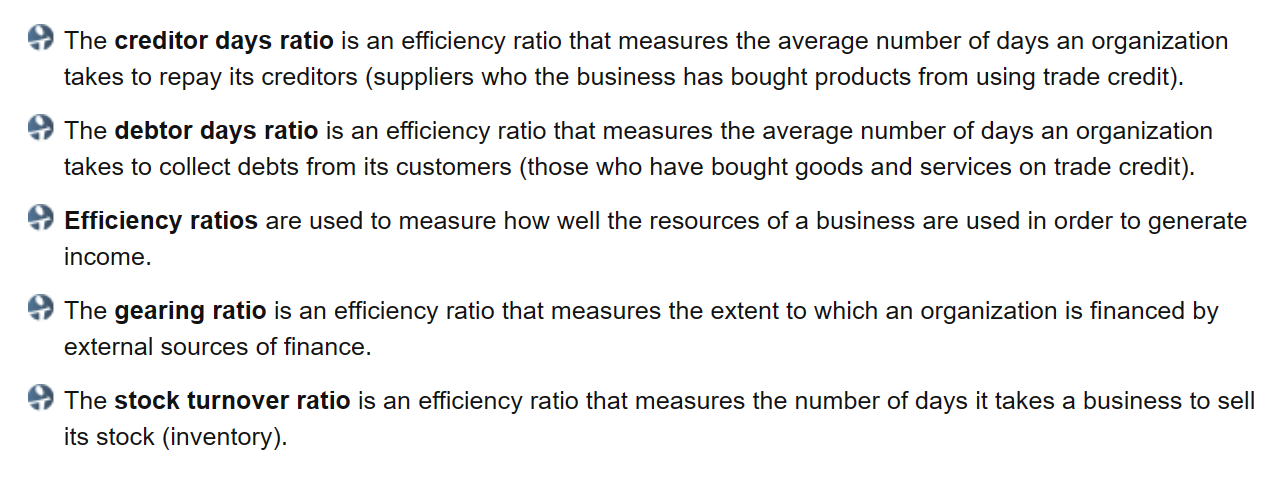- tells you how well the resources of a business are used to generate income from capital
- organization’s resources in terms of liabilities and assets
- HOW WELL YOUR COMPANY USES financial resources (i.e. make money with money?) 4 types of efficiency ratios
- stock turnover ratio (or inventory turnover ratio)
- debtor days ratio
- creditor days ratio
- gearing ratio
Why are efficiency ratios important
- helps manage inventory (make sure you have enough in stock for a predicted demand)

Stock turnover ratio
- tells you how quickly a company sells its inventory
 Calculate average stock:
Calculate average stock: - grocery stores want a high turnover rate (because they can’t sell rotting food)
How to improve your stock ratio
- Get rid of obsolete inventory
- Sell less products (easier to maintain a shorter product list, better for management)
- Use Just in Time manufacturing
Debtor days ratio
- measures how long it takes for a business to get debts from their customers (i.e. they bought goods on credit)

- Goal with debtor days ratio: you want to maintain cash flow and cash liquidity
- The lower the debtors ratio, the better (means if the debt isn’t paid you don’t go bankrupt)
Improve debtors day ratio
- you don’t want a high debtors day ratio ⇒ means you’re getting a lot of credit sales. So, you want to get paid earlier or allow less customer to pay with credit
- Incentivize customers to pay with cash rather than credit (i.e. give cash discount)
- shorten the credit period to customers (so they have to pay quicker)
- Stricter criteria for which customers qualify to pay on credit
Creditor days ratio
- like debtors day but in reverse
- measures the time it takes for a company to pay it’s loans (i.e. the business uses trade credits to purchase products)

- credit days ratio are important: the longer you wait to pay a loan, the more interest you accrue. Which is bad.
- Improve credit days ratio:
- “negotiate an extended credit period with the firm’s supplier’s"
- "Looking for different suppliers who prefer preferential trade credit agreements”
- what is preferential trade credit agreement?
- ”Use cash for inventories (cost of sales) instead of over-relying on trade credit”
Gearing ratio
- tells you to what extent an organization is externally funded

- non-current liabilities: loan capital
- capital employed: sum of non-current liabilities and equity Gearing ratio can tell you if you are in a good position to take on debt
- high gearing ratio: if interest rates increase you’re screwed, so don’t take more loans
- you’re going to have to pay higher loan interest payments (new debt + old debt)
How to improve your gearing ratio
- Pay off long term liabilities (loan capitals)
- Increase the firm’s working capital (increase cash flow? make debtors pay quicker)
- Rely on or increase the use of internal finances (since external finance gets loans)
Watch this video perhaps: https://youtu.be/UuahUYKvV1k
